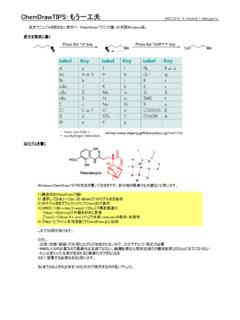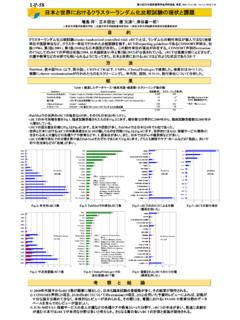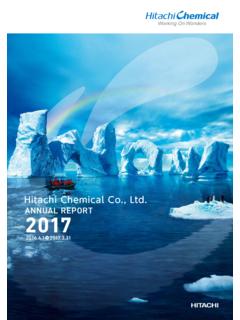Transcription of ApplicationofBioisosteresinDrugDesign - University …
1 Literature Seminar Yuya Morita (M1). Application of Bioisosteres in Drug Design O O. H F. N N. O. N. N. OH. H. Contents 1. Introduction ~What are Bioisosteres? ~Drug-like Concepts 2. Application of Isosteres in Drug Design ~Fluorine as an Isostere of Hydrogen ~Carboxylic Acid Isosteres ~Phenol Isosteres ~Amide and Ester Isosteres ~Phenyl Ring Isosteres 3. Oxetanes in Drug Discovery ~Physicochemical Properties of Oxetanes ~Oxetanes as Isosteres ~Preparation of Oxetanes 4. Summary 1. Introduction What are bioisosteres? Isostere The isostere concept was formulated by Irving Langmuir in 1919. J. Am. Chem. Soc. 1919, 41, 1543. The octet theory of valence indicates that if compounds having the same number of atoms have also the same total number of electrons, the electrons may arrange themselves in the same manner. In this case the compounds or groups of atoms are said to be isosteric.
2 Such compounds should show remarkable similarity in physical properties, that is, in those properties which do not involve a separation of the atoms in the molecule. Irving Langmuir Isosteres were initially defined as those compounds or groups of atoms that have the same number and arrangement of electrons. A further extension to this concept of isosteres came about in 1925 with Grimm's Hydride Displacement Law. "Atoms anywhere up to four places in the periodic system before an inert gas change their properties by uniting with one to four hydrogen atoms, in such a manner that the resulting combinations behave like pseudoatoms, which are similar to elements in the groups one to four places respectively, to their right.". Erlenmeyer further broadened Grimm's classification in 1932. Isosteres were redefined as atoms, ions, and molecules in which the peripheral layer of electrons can be considered identical.
3 Bioisostere The emergence of the concept of bioisoteres as structurally distinct compounds recognized similarly by biological systems has its origins in a series of studies published by Erlenmeyer in the 1930s. The term "bioisostere" was introduced by Harris Friedman in 1950 who defined it as compounds eliciting a similar biological effect. More recently this definition of bioisosteres has been broadened by Burger as "Compounds or groups that possess near-equal molecular shapes and volumes, approximately the same distribution of electrons, and which exhibit similar physical properties.". Prog. Drug Res. 1991, 37, 287. Erlenmeyer showed that antibodies were unable to discriminate between phenyl and thienyl rings or O, NH, and CH2 in the context of artificial antigens. the changes induced by the application of bioisosteres The design of bioisosteres introduces structural changes that can be beneficial or deleterious depending on the context.
4 Size, shape, electronic distribution, polarizability dipole, polarity, lipophilicity, pKa In the contemporary practice of medicinal chemistry The development and application of bioisosteres have been adopted as a fundamental tactical approach useful to address a number of aspects associated with the design and development of drug candidates. improving potency, enhancing selectivity, altering physical properties reducing or redirecting metabolism, eliminating or modifying toxicophores acquiring novel intellectual property Classical and Nonclassical Bioisosteres classical bioisostere Chem. Rev. 1996, 96, 3147. Classical bioisosteres represent the results of an early appreciation of the concept and encompass structurally simple atoms or groups. 1) monovalent atoms or groups 3) trivalent atoms or groups D and H CH=, N=. F and H. NH2 and OH. RSH and ROH 4) tetrasubstituted atoms F, OH, NH2 and CH3 R4C, R4Si, R4N+.
5 Cl, Br, SH and OH. 5) ring equivalent 2) divalent atoms or groups C=C, C=N, C=O, C=S N. CH2 , NH , O , S , nonclassical bioisostere Nonclassical bioisosteres are structually distinct, usually comprise different number of atoms and exhibit different steric and electronic properties. Nonclassical bioisosteres have been devided into two subgroups. 1) cyclic and noncyclic isosteres 2) exchangeable group isosterism in which the properties of discrete functional elements are emulated O N N. CO2H N. R1 OH N. H. O. R2 CO2H O. S. R3 R. N. N O H. MAOMM. (methyleneaminoxy)-methyl moiety Carboxylic Acid Isosteres Drug-like Concepts The application of guidelines linked to the concept of drug-likeness, such as the "rule of five", has gained wide acceptance as an approach to reduce attrition in drug discovery and development. Lipinski's Rule of Five Adv. Drug. Del. Rev.
6 1997, 23, 3. Lipinski's rule states that, poor absorption or permeability is more likely the molecular weight is greater than 500 daltons the clogP(the calculated 1-octanol-water partition coefficient) is greater than 5. the number of hydrogen-bond donors(OH, NH) is more than 5. the number of hydrogen-bond acceptors(O, N) is more than 10. Lipophilicity in Drug Discovery Expert Opin. Drug Discov. 2010, 5, 235. The role of lipophilicity in determining the overall quality of candidate drug molecules is of paramount importance. Recent developments suggest that, as well as determining pre-clinical ADMET (absorption, distribution, metabolism, excretion and toxicology) properties, compounds of optimal lipophilicity might have increased chances of success in development. Solubility logP > 3 only 1% were soluble (having kinetic solubility > 250 g/mL). logP < 3 50% were soluble Permeability logP > for MW 350 - 400 logP > for MW 400 - 450.
7 To achieve high permeability logP > for MW 450 - 500 logP > for MW > 500. Clearance and Metabolism With respect to metabolic stability, logD < 3 is desirable. On the other hand, reducing logD leads to increasing renal clearance. 50% of the compounds that showed net renal secretion had calculated logD < 0. 50% of the compounds that showed net renal reabsorption had calculated logD > Bioavailability Bioavailability can be considered to be a composite of the effect of solubility, permeability and metabolic stability. It has been suggested that the optimal range is 0 < logP < 3, 1 < logD < 3. Toxicity In principle, more lipophilic compounds might be expected to be more promiscuous, that is, lack of selectivity. So more lipophilic compounds are likely to be more toxic. hERG potencies diminish significantly as logD increases the risk of a compound causing phospholipidosis increases if logP2 + pKa2 is > 90.
8 For a base with a pKa of 9, logP < 3 is desirable. the average CYP inhibition are significantly lower for compounds with logP < 3. (A) shows the regions of lipophilicity where good overall compounds are distributed (B) shows where properties are compromised for logD(orange) and logP(light blue). 2. Application of Isosteres in Drug Design Fluorine as an Isostere of Hydrogen The unique properties of fluorine have led to its widespread application in drug design as an isostere for hydrogen, since incorporation of fluorine can productively modulate a range of properties of interest to medicinal chemists. ChemBioChem 2004, 5, 637. Metabolic stability The effect on the pKa block the metabolically labile site with a fluorine As the most electronegative atom, fluorine has substituent, hoping that the small fluorine atom a very strong effect on the acidity or basicity of will not impair the binding to the target protein nearby functional groups.
9 The effect on molecular lipophilicity A survey of 293 pairs of molecules that differed only by a F-for-H exchange revealed that the average lipophilicity(logD) increased by log units. But there are quite a number of cases (shown below) for which an H to F substitution decreases lipophilicity. A close inspection of these cases revealed that all compounds were found to have at least one low-energy conformer with an O F distance smaller than . The effect on molecular conformation -fluorinated carbonyl derivatives favor a conformation in which the C-F and C=O bonds adopt a trans orientation to align the dipoles in an antiperiplanar. ~ kcal/mol The modestly prefered(~ kcal/mol) conformation of benzyl fruoride projects the C-F bond orthogonal to the aryl ring, stabilized by donation of electron density from the aryl -orbital into the *C-F. antibonding orbital.
10 The electrostatic interaction between F( - ) and NH( +) has a effect on conformational preferences O. R1. NH. HN N O. R2. O O. O R N. N O 1 NH O. N. N N N. N O. H R2 N. When R1=H and R2=F When R1=F and R2=H. ~3 kcal/mol favored ~3 kcal/mol favored Carboxylic Acid Isosteres Isosteres of carboxylic acid have been studied extensively. These studies have typically focused enhancing potency reducing polarity increasing lipophilicity (improve membrane permeability). enhancing pharmacokinetic properties reducing the potential for toxicity application (Angiotensin II receptor antagonists). nBu N. Cl pKa N N. logP Et O Ph IC50 19 nM 200 nM N N N. OH N O N NH. H O S NH. N N O. N. N OH MK-996. Losartan resistance toward glucuronidation Phenol Isosteres Phenol and catechol isosteres were typically designed to ovecome pharmacokinetic and toxicological limitations. A range of useful surrogates are well-established.





